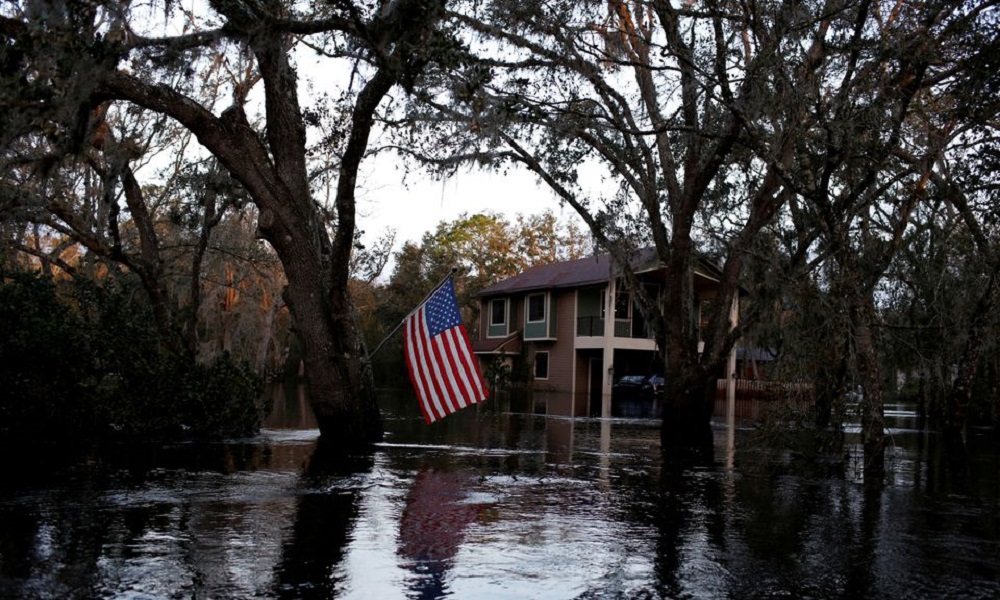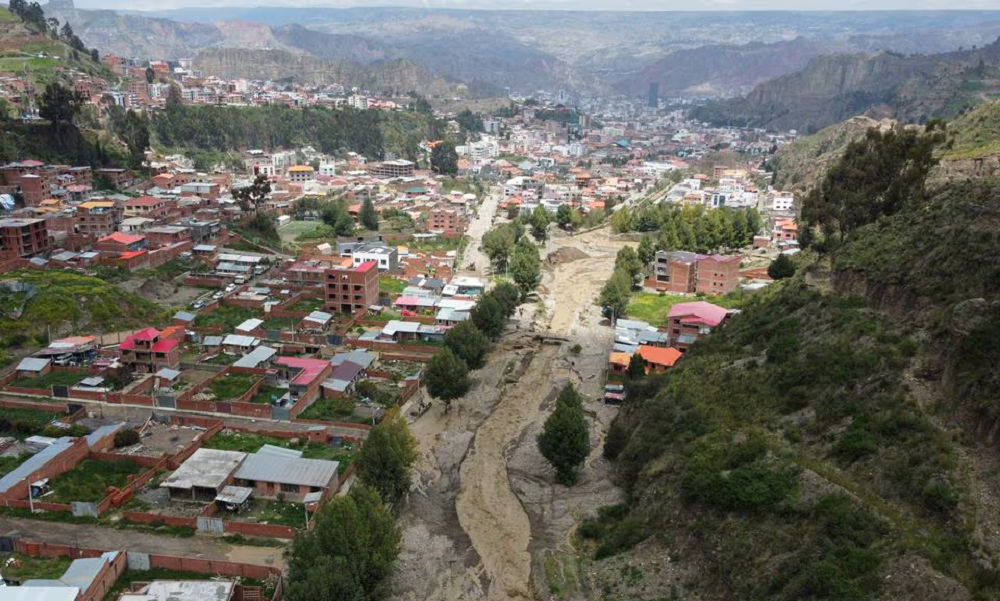Climate Change
For flooded inland Florida, Hurricane Ian saved the worst for last

Hurricane Ian carried a one-two punch for the inland Florida city of Arcadia and its surrounding county.Located 50 miles north of Fort Myers and about 50 miles east of the Gulf Coast, Arcadia first suffered the immediate effects of the Category 4 storm as it swept east, bringing torrential rains and hurricane-force winds to the interior of the state.
A second blow came when the Peace River, which twists past Arcadia on its way to the Gulf of Mexico, spilled over its banks. Normally a slow-moving waterway where kayakers coexist with alligators, the river inundated parts of the city and many of the surrounding farms and cattle ranches, Reuters reported.
In coastal Florida, utilities are still trying to restore power, especially in the Fort Myers area, which felt the brunt of the storm. But further inland, extensive flooding triggered by the storm persists in much of DeSoto County, including Arcadia.
Some homes there could only be reached this week by boat or by wading through chest-deep water. In a nearby park, camping trailers bobbed like corks in an oily sea of floodwater that sprawled over the pancake-flat landscape in all directions.
Flooding of such a magnitude has never happened on the Peace River “in anyone’s lifetime,” said Sara Walker, a DeSoto County official, who described it as an event expected to occur only once every 500 years.
Inland flooding, which shut down parts of Florida’s interstate highways for days, is a grim reminder that hurricane damage is not limited to coastal areas.
In the days following hurricanes, water runoff can dangerously swell rivers, a phenomenon called sheet flow. The U.S. National Oceanic and Atmospheric Administration has said that more than half of deaths related to hurricanes are typically related to inland floods.
Walker said officials have not confirmed any deaths in DeSoto County related to Ian, which killed at least 100 people statewide. But inland flooding in Florida is likely to contribute significantly to damages caused by a hurricane that will cost insurers an estimated $57 billion.
Plumber Jamie Buenger, 52, has been forced to sleep in his truck after the Peace River flooded his home and made it inaccessible except by boat. He has not been able yet to check how badly it has been damaged because downed power lines and trees make travelling through the floodwater too dangerous.
“The hard part is going to be when you go in, go through your belongings, filling up garbage cans,” he said. “That’s when it’s really going to hit you.”
The National Weather Service forecasts that the area around the Peace River will remain a major flood zone until Saturday.
Neighbor Tom D’Angelo, 60, a retired firefighter, said the house he shares with his wife and two grandchildren near the Peace River was destroyed, along with his camper and truck.
Climate Change
UN sounds ‘Red Alert’ as world smashes heat records in 2023

Every major global climate record was broken last year and 2024 could be worse, the World Meteorological Organization (WMO) said on Tuesday, with its chief voicing particular concern about ocean heat and shrinking sea ice, Reuters reported.
The U.N. weather agency said in its annual State of the Global Climate report that average temperatures hit the highest level in 174 years of record-keeping by a clear margin, reaching 1.45 degrees Celsius above pre-industrial levels.
Ocean temperatures also reached the warmest in 65 years of data with over 90% of the seas having experienced heatwave conditions during the year, the WMO said, harming food systems.
“The WMO community is sounding the Red Alert to the world,” said WMO Secretary-General Celeste Saulo, who took over the job in January.
“What we witnessed in 2023, especially with the unprecedented ocean warmth, glacier retreat and Antarctic sea ice loss, is cause for particular concern.”
She later told reporters that ocean heat was particularly concerning because it was “almost irreversible”, possibly taking millennia to reverse.
“The trend is really very worrying and that is because of the characteristics of water that keep heat content for longer than the atmosphere,” she said.
Climate change, driven by the burning of fossil fuels, coupled with the emergence of the natural El Nino climate pattern, pushed the world into record territory in 2023, read the report.
WMO’s head of climate monitoring, Omar Baddour, told reporters there was a “high probability” that 2024 would set new heat records, saying that the year after an El Nino was typically warmer still.
Tuesday’s report showed a big plunge in Antarctic sea ice, with the peak level measured at 1 million km2 below the previous record – an area roughly equivalent to the size of Egypt.
That trend, combined with ocean warming which causes water to expand, has contributed to a more than doubling of the rate of sea-level rise over the past decade compared with the 1993-2002 period, it said.
Ocean heat was concentrated in the North Atlantic with temperatures an average 3 degrees Celsius above average in late 2023, the report said. Warmer ocean temperatures affect delicate marine ecosystems and many fish species have fled north from this area seeking cooler temperatures, Reuters reported.
Saulo, a meteorologist from Argentina who has promised to strengthen global warning systems for climate disasters, said she hoped the report would raise awareness of the “vital need to scale up the urgency and ambition of climate action”.
“That’s why we spoke about the Red Alert because we must care for the people and how they will suffer from these more frequent, more extreme events,” she told reporters. “If we do nothing, things will become worse and that will be our responsibility.”
Climate Change
Pakistan, India and Bangladesh bottom in air quality rankings in 2023

Pakistan remained one of the world’s three smoggiest countries in 2023, as Bangladesh and India replaced Chad and Iran, with particulate matter about 15 times the level recommended by the World Health Organization, data published on Tuesday showed.
Average concentrations of PM2.5 – small airborne particles that damage the lungs – reached 79.9 micrograms per cubic meter in Bangladesh in 2023, and 73.7 micrograms in Pakistan. The WHO recommends no more than 5 micrograms.
“Because of the climate conditions and the geography (in South Asia), you get this streak of PM2.5 concentrations that just skyrocket because the pollution has nowhere to go,” said Christi Chester Schroeder, air quality science manager at IQAir, a Swiss air-monitoring organisation.
“On top of that are factors such as agricultural practices, industry and population density,” she added. “Unfortunately, it really does look like it will get worse before it gets better.”
In 2022, Bangladesh was ranked as having the fifth-worst air quality, and India was eighth.
About 20% of premature deaths in Bangladesh are attributed to air pollution, and related healthcare costs amount to 4%-5% of the country’s GDP, said Md Firoz Khan, an air pollution expert at Dhaka’s North South University.
Indian pollution also increased last year, with PM2.5 levels about 11 times higher than the WHO standard. India’s New Delhi was the worst-performing capital city, at 92.7 micrograms.
Only Australia, Estonia, Finland, Grenada, Iceland, Mauritius and New Zealand met WHO standards in 2023.
The IQAir report was based on data from more than 30,000 monitoring stations in 134 countries and regions.
Chad, the world’s most polluted country in 2022, was excluded from the 2023 listings because of data issues. Iran and Sudan were also taken off the 2023 list.
Afghanistan was meanwhile not included on the list.
Climate Change
In Bolivia, heavy rains prompt authorities to declare state of emergency

Heavy rain in Bolivia’s capital, La Paz, prompted authorities to declare a state of emergency, a government document showed on Sunday, after overflowing rivers destroyed many houses over the weekend.
Bolivian President Luis Arce pledged to send heavy machinery and 3,000 troops to prevent further damage, according to the document, Reuters reported.
Heavy rains caused flooding in several neighborhoods and isolated parts of the city by cutting water, electricity and roads.
“We are deeply concerned by the difficult situation that our municipality in La Paz is going through,” Arce said in a post on social media platform X.
One person died over the weekend in La Paz because of the heavy rains, while nearly 50 people have died in deluges across the country since the rainy season began in January, according to official data.
-

 Regional5 days ago
Regional5 days agoIndian foreign ministry advises against travel to Iran, Israel
-

 Latest News5 days ago
Latest News5 days agoLightning strikes in Helmand kill one, injure three
-

 Latest News5 days ago
Latest News5 days agoTop former US general claims Daesh-Khorasan is ‘on the upswing’
-

 Business4 days ago
Business4 days agoAfghanistan reaches self-sufficiency in production of 133 items: MoIC
-

 Sport3 days ago
Sport3 days agoACL draw to be broadcast live on ATN channels
-

 Health4 days ago
Health4 days agoMajority of Afghans with mental disorders are women: officials
-

 Regional3 days ago
Regional3 days agoIRGC chief warns of harsher response if Israel attacks Iran
-

 Regional5 days ago
Regional5 days agoGunmen kill 9 men after abduction in southwest Pakistan
























